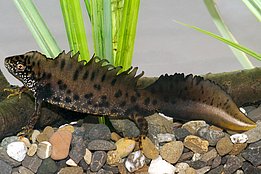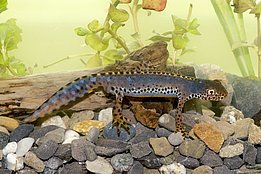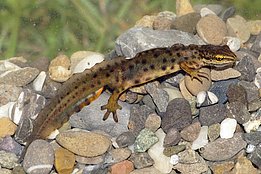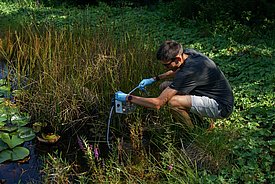17.09.2024 | Haoyun Liu | WSL News
79% of amphibian species are on the Red List of threatened species in Switzerland. How can we better understand them to improve conservation? An ETH-WSL joint research team developed DNA detectors to rapidly identify amphibian species in pond water samples. They tested their method successfully in Aargau.
Amphibians are among the most threatened taxonomic group in Switzerland. Of the 19 Swiss species evaluated in 2023, 15 are on the Red List from the Federal Office for the Environment. To better protect animals at risk and maintain biodiversity, it is essential to monitor how their population and distribution changes overtime.
Flurin Leugger, a PhD student, and his colleagues from the joint ETH-WSL Ecosystems and Landscape Evolution research group, identified the need for improved methods in biodiversity monitoring. In an article published last month in Molecular Ecology Resources, the team present a new technique they have developed for amphibian monitoring. To test this new approach, they applied it to nine ponds in the canton of Aargau.
Traditional monitoring methods are labour intensive and time consuming. Trained experts visit amphibian reproduction sites – ponds, for example – and record the species they see, or hear, if they are lucky enough to encounter them. This does not always paint a full picture: some species might be left unrecorded even after multiple visits.
DNA clues in water bodies ¶
Alternatively, molecular methods have been developed to monitor species using environmental DNA (eDNA), providing a more comprehensive view. As living organisms feed, shed cells and excrete, they leave pieces of DNA in the environment. Scientists collect this eDNA from the habitat to identify the species living within it. For amphibians, a sample of water from the pond holds the clues to the population inside it.
However, current best practices for eDNA analysis are not adapted for biodiversity monitoring of a small group of species, such as endangered or invasive amphibians. On one hand, metabarcoding (see Box) is best for detecting large groups of species living in the same environment. It is expensive, and the results are slow to obtain and analyse. On the other hand, qPCR is more appropriate for detecting the presence of a single species at a time (see Box). What about a situation somewhere in between: when we want to check for the presence of a handful of endangered species, for example?
Leugger and colleagues developed an elegant solution, calling it “ampliscanning”. The name refers to two key steps in the method: amplification and scanning. Firstly, as amphibian DNA is present in very small quantities in the ponds, it is copied many times to facilitate detection. Then, they looked for 7 Swiss amphibian species by constructing molecular detectors. These scan the amplified amphibian DNA and become fluorescent if DNA from the matching species is present. “This lets us look for specific endangered or invasive species. It’s faster and more efficient than previous methods.”, says Leugger. The biggest challenge in this project was making sure these detectors were species-specific. “Because when you detect, let's say, a rare species, like a smooth newt, you want to be sure that it's really this newt and not the common toad which made the signal.”, explains Leugger.
Ampliscanning in practice ¶
To test this new method, the scientists analysed eDNA from nine amphibian habitats in Aargau and compared their results to traditional monitoring data from the canton. Ampliscanning detected more species in a single visit than three traditional monitoring visits.
Interestingly, this increase in efficiency was higher for elusive species. More newts were found in more locations using ampliscanning, as newts hide in the underwater vegetation and are difficult to spot. On two sites only, traditional monitoring detected European tree frogs while eDNA did not, as they have a distinctive loud call at night. As eDNA is not evenly distributed, it could be that the sampled areas did not contain any traces of the European tree frog’s DNA.
Ampliscanning can be adapted to other species. It makes genetic monitoring of biodiversity more accessible and cost-efficient. The next step is to create quick tests, performed directly in the field and available for the public to promote large-scale biodiversity monitoring. The new technique helps create a better understanding of threatened species and improve their conservation measures.




Genetic methods in conservation ¶
Essentially, ampliscanning streamlines biodiversity monitoring by combining aspects from three methods. It is more specific than metabarcoding but less restrictive than qPCR, and it benefits from the adaptability and precision of CRISPR-Diagnostics.
Polymerase chain reaction (PCR) copies a target section of DNA multiple times. When specific DNA primers are used as in quantitative PCR (qPCR), they can search for the presence of a particular DNA sequence – or species – in a sample, as it was done for COVID testing, for example. However, this specificity of the primer makes it difficult to use qPCR for monitoring multiple species at once.
Primers define the start and end of the amplified DNA segment in PCR. These are short pieces of synthetic DNA, specific to the section of interest. Designing and testing these primers is a labour-intensive process.
Metabarcoding amplifies DNA sections from eDNA that are common across a species group. There are standard primers targeting all amphibians or fish, for example. The amplified DNA is then sequenced, to compare the genetic code to databases and identify the species present in the sample. This part is costly and time consuming.
CRISPR-Diagnostics (Dx) use bacterial proteins to identify species-specific DNA content. CRISPR-Dx are essentially bio-detectives, mostly used in medical contexts, such as Zika virus detection. The CRISPR-Dx system recognizes specific sections of the DNA with the help of guide sequences. These guide sequences can be designed to detect any given DNA sequence and are highly specific, making them more efficient and easier to design compared to qPCR primers. Upon target recognition, a fluorescence signal is emitted.
Ampliscanning combines the principle of these methods: metabarcoding primers to amplify DNA from a species group and a CRISPR-Dx system to detect specific DNA sequences within the amplified DNA. This allows for species-specific detections similar to qPCR but enables the detection of multiple species simultaneously. Thus, ampliscanning avoids the costly and time-consuming sequencing required by metabarcoding.
Contact ¶
Publication ¶
Copyright ¶
Copyright: The Swiss Federal Research Institute WSL provides the artwork for imaging of press articles relating to this media release for free. Transferring and saving the images in image databases and saving of images by third parties is not allowed.


